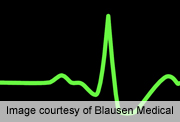Such screenings don’t predict who will have a future cardiovascular event, researchers report
TUESDAY, Jan. 27, 2015 (HealthDay News) — For patients seen in emergency departments solely for chest pain not due to myocardial infarction, noninvasive screening tests for coronary heart disease do not appear to benefit the prediction of future cardiovascular events, a new study suggests. The report was published online Jan. 26 in JAMA Internal Medicine.
Andrew Foy, M.D., an assistant professor of medicine and public health sciences at the Penn State Milton S. Hershey Medical Center, and colleagues used health insurance claims from a group of 693,212 privately insured patients seen in emergency departments for chest pain in 2011. From this group, the authors included 421,774 patients in their final analysis, of whom 293,788 did not receive noninvasive tests and 127,986 received exercise electrocardiography, stress echocardiography, myocardial perfusion scintigraphy, or coronary computed tomography angiography.
According to Foy, the percentage of patients hospitalized for a myocardial infarction was only 0.11 percent a week after being seen in the emergency department and only 0.33 percent 190 days after being seen. Patients who did not have initial noninvasive tests were no more likely to have a myocardial infarction than those who did receive testing, the researchers found. Patients who received these tests, however, were more likely to have invasive procedures such as angioplasty. Yet these procedures did not improve the odds against having a myocardial infarction, Foy told HealthDay.
In an editor’s note that accompanied the study, Rita Redberg, M.D., editor-in-chief of JAMA Internal Medicine, said such tests in low-risk patients are unnecessary and prolong time spent in the emergency department. “It is time to change our guidelines and practice for treatment of chest pain in low-risk patients,” Redberg writes. “Such patients should be given a close follow-up appointment with a primary care physician who can determine, based on the patient’s condition, whether further evaluation is necessary.”
Abstract
Full Text (subscription or payment may be required)
Editor’s Note (subscription or payment may be required)
Copyright © 2015 HealthDay. All rights reserved.








